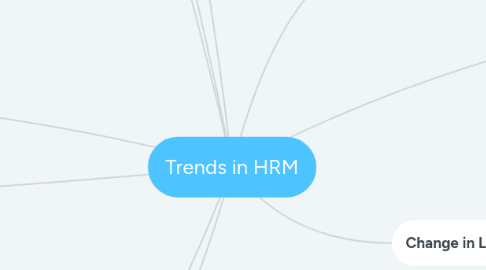
1. Employee Self-Service: employees have online access to information about HR issues (enroll in programs and provide feedback through surveys)
2. Technical Trends
2.1. HR analytics: process of collecting and analyzing Human Resource (HR) data in order to improve an organization's workforce performance.
3. Total Quality Management (TQM)
3.1. a companywide effory to continuously improve the ways people, machines and systems accomplish work
4. HRM have a significant role as there will be differences between businesses = conlicts are inevitable Training should include developing conflict resolution skills A need to sort out differences between 2 companies
5. HR Information System (HRIS): computer system which is able to 1) support strategic decision making 2) help the organization avoid lawsuits 3) provide data for evaluating programs / policies 4) support day-to-day HR decisions
6. High-Performance Work Systems
6.1. Social Trends
6.1.1. Knowledge Workers: employees whose contribution is specialised knowledged
6.1.2. Employee Empowerment: employees having responsibility & authority to make decisions regarding ALL aspect Employee Engagement: full involvement in work & commitment to job -> higher productivity, better customer service, lower employee turnover
6.1.3. Temwork: employees with various skills (interact and come up with product / services)
6.1.4. Business Partnering: Human Resource professional who actively integrates the business strategy with people management practices (advisor)
7. Strategic Business Issues Affecting HRM
7.1. Mergers & Acquisitions
7.2. Reengineering
7.2.1. offshoring: moving operations to another country where pay rates are lower but neccessary skills are available international labor pool: immigration, expatriates
7.2.2. a complete review of organization's major work processes -> more efficient & deliver higher quality
7.3. A state where organizations achieve the best possible fit between their social & technical systems.
7.4. International Expansion
7.5. Downsizing (ie. retrenchment)
7.6. Outsourcing
7.6.1. the practice of having another company (e.g. vendor, third-party provider) -> gives company access to in-depth expertise + economical
8. individuals who are actively seeking employment
9. Labour Force
9.1. Internal
9.1.1. an organisation's worker
9.2. External
10. Change in Labour Force
10.1. Aging Workforce
10.1.1. HR spend much time on concerns relating to older workers (careers have reached a plateau)
10.2. Skill Deficiencies of the Workforce
10.2.1. Employers are looking for: Mathematical, Verbal, Interpersonal & Verbal Skills
10.3. Diverse Workforce
10.3.1. Organisations: 1) struggle with ways to control rising costs of health care & other benefits 2) have to find ways to attract & retain younger workforce 3) mentoring programs = knowledge is passed on
10.3.1.1. Diversity Management: Employee Relations, Performance Aprraisal, Development, Communications
10.3.2. Gap between skills needed vs available = decreased companies ability to compete
